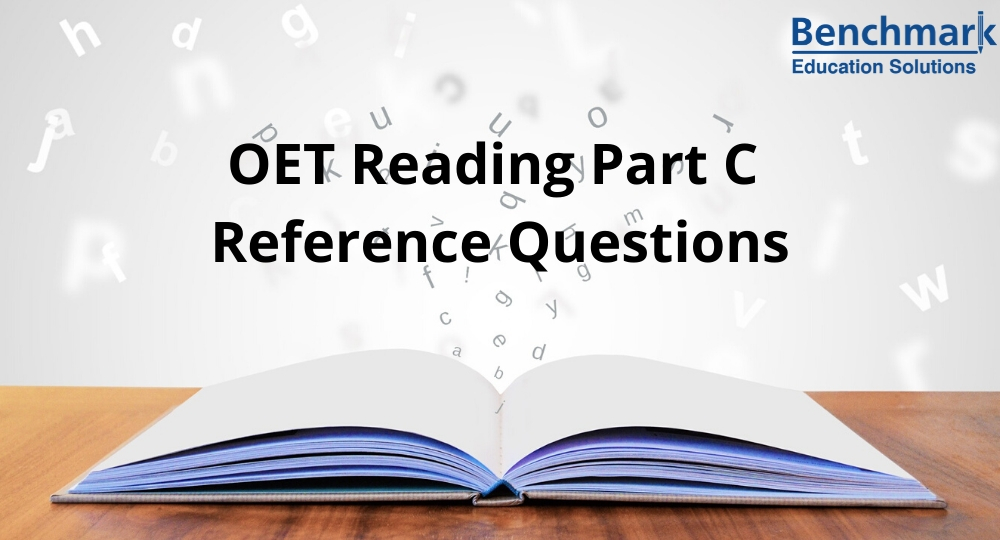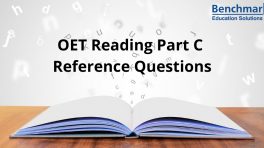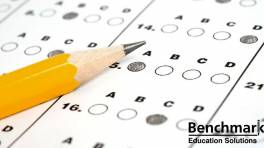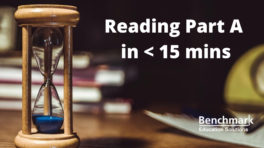Answering Reference Questions in OET Reading Part C
- 19 Comments


One important reading skill is understanding reference words. This is a basic skill which most of us already have but may not have given it much thought until we are asked a question about it in an exam setting. In the OET Reading sub-test, reference questions are common in Part C of this test. So, what are reference words?
Reference words are words which are used to refer to something which is mentioned either BEFORE or AFTER it. References are used as a form of synonym in order to avoid repeating something too often. We use it every day ourselves but we may not realise it. Let’s look at a simple example.
Example 1
- Henry loves ice-cream. He has one almost every day. It is his favourite dessert.
From the above example, there are two reference words highlighted in bold – ‘he’ and ‘it’. If you were asked, “What does the word ‘he’ refer to?” the answer is quite simply ‘Henry’. Similarly, it is quite easy to identify what ‘it’ refers to. Just replace ‘it’ with ‘what’ in the sentence. Here, let us show you how:
- ‘It is his favourite dessert.’
- ‘What is his favourite dessert?’
- Note: You are essentially asking “What is ‘it’?”
So, you will need to read the surrounding sentences in order to find the meaning of ‘it’. Here, the answer is ‘ice-cream’
Sound easy? It is! Do take note that in this example, both words (‘he’ and ‘it’) are pronouns. However, you need to bear in mind that reference words may consist of more than just single-word pronouns in your OET Reading test. Let’s look at a few more difficult examples now – ones which resemble reference-word questions you may get in your exam.
Example 2
- “Calcium supplements are frequently associated with gastrointestinal symptoms and they have also been reported to double the risk of hospital admissions related to abdominal symptoms,” the authors wrotei .
- Question: What do ‘they’ refer to in the above sentence?
In the same way, you will need to ask “What are ‘they’?” Read the part BEFORE and AFTER the word. Inthis case, you need to read what the passage says about this word, ‘they’. It says ‘they have also been reported to double the risk of hospital admissions related to abdominal symptoms’.
[contact-form-7 id=”4672″ title=”OET Listening”]
So, whatever answer you look for must make sense in this context and ‘they’ are something which can double the risk of hospital admissions. Now, read the part before the word ‘they’. It says ‘Calcium supplements are frequently associated with gastrointestinal symptoms’. This is a tricky one. Should your answer be ‘Calcium supplements’ or ‘gastrointestinal symptoms’? Which one can double the risk of hospital admissions? At a glance, it looks like ‘gastrointestinal symptoms’ may be the answer as people are admitted to the hospital because of these symptoms, but WAIT! Read the entire sentence….it says ‘double the risk of hospital admissions related to abdominal symptoms’. How can ‘gastrointestinal symptoms’ be correct if the final part of the sentence mentions ‘related to abdominal symptoms’ again? So, the correct answer is actually ‘calcium supplements’.
Let us consider another example.
Example 3
- Managing persons at risk of suicide is complex and requires collaborative partnership between the affected person and her/his support network, and a multidisciplinary healthcare team ii.
- Question: What does ‘the affected person’ refer to in the above sentence?
In Example 3, you are looking for ‘the affected person’. Who is ‘the affected person’? Think about it. If someone were to ask you this random question ‘Who is the affected person?’ your first question would be ‘What is he affected with?’ because you will not be able to answer this question unless you know what the person is affected with. So, if you read the earlier part of the sentence, you can safely say that ‘the affected person’ is someone who is ‘at risk of suicide’. At this point, you may have a question about the singular and plural forms here. For instance:
- The question is asking for a singular reference – the affected person
- The answer in the sentence refers to a plural noun phrase – persons at risk of suicide
Do not be unduly worried about the singular and plural forms in Part C of the OET Reading sub-test. The reason for this is that all the questions in this section are multiple-choice questions and you just need to select the answers from A, B, C or D options. Just choose the answer that best resembles what you have determined the reference word is pointing to.
Here are two more examples.
Example 4
- Nerve tissues and muscle surround the prostate. This makes it quite difficult to precisely remove or target with radiation iii.
- Question: What does ‘this’ refer to?
By now, you should know how to mentally ask yourself this question ‘What makes it difficult to precisely remove or target with radiation?’The answer should be ‘Nerve tissues and muscle surround the prostate’.
Example 5
- But since the situation is not as clear cut regarding the link between using aspirin before diagnosis and outcomes following breast cancer treatment, Wang and colleagues decided to take a closer look at the one place likely to hold the answers — human DNA iv.
- Question: What does ‘the situation’ refer to?
Example 5 is slightly different than the other examples we have examined because the answer is not found in a section BEFORE the reference word/s, but is actually found AFTER that. The question you should ask yourself in this context is “What ‘situation’ are you talking about?”. There is a clue in the sentence. The clue is the word ‘regarding’. So, the situation is ‘regarding’ that particular thing. Thus, the answer is ‘the link between using aspirin before diagnosis and outcomes following breast cancer treatment’.
Reference questions are not that difficult to answer if you have practiced many sets of reading tests with those questions. Remember, Part C of the OET Reading sub-test will account for 16 marks out of a total of 42 marks for the entire reading test, so Part C is very important. If you are concerned and feel that you are not ready for it, just practice more. You will get the hang of it pretty soon. If you need OET Reading practice materials, you can click this OET reading course link for some extra help
Free Writing OET Materials
3. OET Materials For Pharmacy
4. OET Materials For Physiotherapy













Very helpful information,l had a C+ in reading still trying Master the techniques to improve my score
Thanks. Keep checking this space – very soon, we’ll be publishing a Master Guide on Reading Part A with a downloadable practice test.
Thank u
Thank you for this breakdown
Very helpful tips. Thank you
good information
good information.When is part A coming?
Here it is: OET Reading Part A Test Guide (Free)
Thank you, very helpful information
Please give reading part b tips and tricks
.
Approach to doing Part B is the same as Part C.
Very helpful indeed. Tanks alot. When is part A coming?
Already here: OET Reading Part A Guide
Sir we do have to score over 70% in part a and b,c seperately or combined score is considered?
combined. Use this reading and listening calculator /
helpful infomation
very helpful
Thanks,will forward to your assistance
The suggestions especially for solving subset Reading part C are quite easy to follow. Thanks for the help.